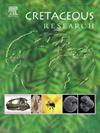Angiosperm fossil woods, Cryptocaryeae (Lauraceae) and Cunoniaceae, with marine borers from Day Nunatak, Western Antarctica (Snow Hill Island Formation, Upper Cretaceous)
IF 1.7
3区 地球科学
Q1 GEOLOGY
引用次数: 0
Abstract
We describe three fossil woods from Day Nunatak, Snow Hill Island collected from outcrops of the Snow Hill Island Formation (Campanian–Maastrichtian). The first specimen is assigned to Longexylon oliveroi gen. et sp. nov., a Cryptocaryeae (Lauraceae), which suggests an Antarctic origin of the Beilschmiedia-Cryptocarya clade. The second specimen is assigned to Eucryphiaceoxylon eucryphioides, which increases the number and biogeographical range of this common fossil-species of Antarctica and Patagonia. The third specimen, less well preserved, is tentatively assigned to the same fossil-species as the second. The three specimens show evidence of biodeterioration by marine wood borers assigned to the ichnospecies Apectoichnus longissimus and Teredolites clavatus. Some T. clavatus borings had subsequent colonization by marine agglutinating organisms. Two borings of one specimen preserved the valves of the borer organism, probably a pholadoid bivalve.
南极西部的Day Nunatak(上白垩纪雪山岛组)的被子植物化石森林,隐树科(樟科)和松果科,含海生蛀虫
我们描述了雪山岛Day Nunatak的三种化石木材,这些化石来自于雪山岛组(Campanian-Maastrichtian)的露头。第一个标本归属于樟科隐树科Longexylon oliveroi gen. et sp. nov.,表明该分支起源于南极。第二个标本被分配给Eucryphiaceoxylon eucryphioides,这增加了南极洲和巴塔哥尼亚常见的化石物种的数量和生物地理范围。第三个标本保存较差,暂定与第二个标本属于同一化石种。这3个标本显示了海生木蛀虫的生物劣化证据,这些蛀虫被分配给了鱼种Apectoichnus longissimus和Teredolites clavatus。一些钉螺钻孔随后被海洋凝集生物定植。一个标本的两个钻孔保存了钻孔生物的瓣,可能是一种双壳类昆虫。
本文章由计算机程序翻译,如有差异,请以英文原文为准。
求助全文
约1分钟内获得全文
求助全文
来源期刊

Cretaceous Research
地学-地质学
CiteScore
4.10
自引率
19.00%
发文量
235
审稿时长
12 weeks
期刊介绍:
Cretaceous Research provides a forum for the rapid publication of research on all aspects of the Cretaceous Period, including its boundaries with the Jurassic and Palaeogene. Authoritative papers reporting detailed investigations of Cretaceous stratigraphy and palaeontology, studies of regional geology, and reviews of recently published books are complemented by short communications of significant new findings.
Papers submitted to Cretaceous Research should place the research in a broad context, with emphasis placed towards our better understanding of the Cretaceous, that are therefore of interest to the diverse, international readership of the journal. Full length papers that focus solely on a local theme or area will not be accepted for publication; authors of short communications are encouraged to discuss how their findings are of relevance to the Cretaceous on a broad scale.
Research Areas include:
• Regional geology
• Stratigraphy and palaeontology
• Palaeobiology
• Palaeobiogeography
• Palaeoceanography
• Palaeoclimatology
• Evolutionary Palaeoecology
• Geochronology
• Global events.
 求助内容:
求助内容: 应助结果提醒方式:
应助结果提醒方式:


